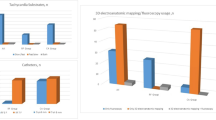Abstract
Background
Catheter ablation is the preferred management approach for atrioventricular nodal reentrant tachycardia (AVNRT). Cryothermal ablation (Cryo) and radiofrequency ablation (RFA) are the two clinically available ablation modalities. Atrioventricular (AV) block is a concerning potential complication and is commonly preceded by transient AV block or rapid junctional beats when using RFA. For challenging AVNRT cases, where RFA produced signs of impending AV block, we evaluate the application of Cryo to the same anatomical location where RFA was abandoned.
Methods
Cryo was applied in 10 out of 313 (3.2%) total AVNRT cases from January of 2007 to June of 2010. In these cases, right-sided RFA failed in eliminating AVNRT and was aborted due to transient AV block or rapid junctional rhythm. Cryo lesions were then applied to the same anatomical location where RFA was discontinued. Patients were followed and evaluated for AVNRT recurrence.
Results
Nine out of ten patients had complete elimination of AVNRT after Cryo, one of whom required a second procedure. This strategy failed in one patient, where left-sided RFA was required to eliminate AVNRT. There was one complication, tamponade, in the failed case, which was successfully managed with no long-term sequelae. There was no AV block.
Conclusion
In this cohort of challenging AVNRT cases where right-sided RFA was aborted due to signs of impending AV block, applying Cryo to the same anatomical location provided procedural success, in all but one case. A prospective study is needed to accurately evaluate the safety and efficacy of this strategy.
Similar content being viewed by others
References
Wu, D., Denes, P., Amat-y-Leon, F., et al. (1978). Clinical, electrocardio- graphic and electrophysiologic observations in patients with paroxysmal supraventricular tachycardia. The American Journal of Cardiology, 41, 1045–1051.
Morady, F. (2004). Catheter ablation of supraventricular arrhythmias: state-of-the-art. Journal of Cardiovascular Electrophysiology, 15, 124–139.
Jackman, W. M., Beckman, K. J., McClelland, J. H., Wang, X., Friday, K. J., Roman, C. A., et al. (1992). Treatment of supraventricular tachycardia due to atrioventricular nodal reentry, by radiofrequency catheter ablation of slow-pathway conduction. The New England Journal of Medicine, 327(5), 313–318.
Haissaguerre, M., Gaita, F., Fischer, B., Commenges, D., Montserrat, P., d’Ivernois, C., et al. (1992). Elimination of atrioventricular nodal reentrant tachycardia using discrete slow potentials to guide application of radiofrequency energy. Circulation, 85(6), 2162–2175.
Friedman, P. L., Dubuc, M., Green, M. S., Jackman, W. M., Keane, D. T., Marinchak, R. A., et al. (2004). Catheter cryoablation of supraventricular tachycardia: results of the multicenter prospective “frosty” trial. Heart Rhythm, 1(2), 129–138.
Kimman, G. P., Theuns, D., Szili-Torok, T., Scholten, M. F., Res, J. C., & Jordaens, L. J. (2004). CRAVT: a prospective, randomized study comparing transvenous cryothermal and radiofrequency ablation in atrioventricular nodal re-entrant tachycardia. European Heart Journal, 25, 2232–2237.
Zrenner, B., Dong, J., Schreieck, J., Deisenhofer, I., Estner, H., Luani, B., et al. (2004). Transvenous cryoablation versus radiofrequency ablation of the slow pathway for the treatment of atrioventricular nodal re-entrant tachycardia: a prospective randomized pilot study. European Heart Journal, 25(24), 2226–2231.
Opel, A., Murray, S., Kamath, N., Dhinoja, M., Abrams, D., Sporton, S., et al. (2010). Cryoablation versus radiofrequency ablation for treatment of atrioventricular nodal reentrant tachycardia: cryoablation with 6-mm-tip catheters is still less effective than radiofrequency ablation. Heart Rhythm, 7(3), 340–343.
Deisenhofer, I., Zrenner, B., Yin, Y. H., Pitschner, H. F., Kuniss, M., Grossmann, G., et al. (2010). Cryoablation versus radiofrequency energy for the ablation of atrioventricular nodal reentrant tachycardia (the CYRANO Study): results from a large multicenter prospective randomized trial. Circulation, 122, 2239–2245.
Avari, J. N., Jay, K. S., & Rhee, E. K. (2008). Experience and results during transition from radiofrequency ablation to cryoablation for treatment of pediatric atrioventricular nodal reentrant tachycardia. Pacing and Clinical Electrophysiology, 31, 454–460.
Sorbera, C., Martin, C., Woolf, P., & Kalapatapu, S. R. (2000). Slow pathway ablation using transseptal approach. Pacing and Clinical Electrophysiology, 23, 1343–1349.
Jaïs, P., Haïssaguerre, M., Shah, D. C., Coste, P., Takahashi, A., Barold, S. S., et al. (1999). Successful radiofrequency ablation of a slow atrioventricular nodal pathway on the left posterior atrial septum. Pacing and Clinical Electrophysiology, 22(3), 525–527.
Meininger, G. R., & Calkins, H. (2004). One method to reduce heart block risk during catheter ablation of atrioventricular nodal reentrant tachycardia. Journal of Cardiovascular Electrophysiology, 15(6), 727–728.
Thakur, R. K., Klein, G. J., Yee, R., & Stites, H. W. (1993). Junctional tachycardia: a useful marker during radiofrequency ablation for atrioventricular node reentrant tachycardia. Journal of the American College of Cardiology, 22(6), 1706–1710.
Khairy, P., Chauvet, P., Lehmann, J., Lambert, J., Macle, L., Tanguay, J. F., et al. (2003). Lower incidence of thrombus formation with cryoenergy versus radiofrequency catheter ablation. Circulation, 107(15), 2045–2050.
Author information
Authors and Affiliations
Corresponding author
Rights and permissions
About this article
Cite this article
Alhumaid, F., Cheng, A., Calkins, H. et al. Successful cryothermal ablation for Atrioventricular nodal reentry tachycardia after radiofrequency ablation failure. J Interv Card Electrophysiol 34, 89–92 (2012). https://doi.org/10.1007/s10840-011-9628-3
Received:
Accepted:
Published:
Issue Date:
DOI: https://doi.org/10.1007/s10840-011-9628-3




